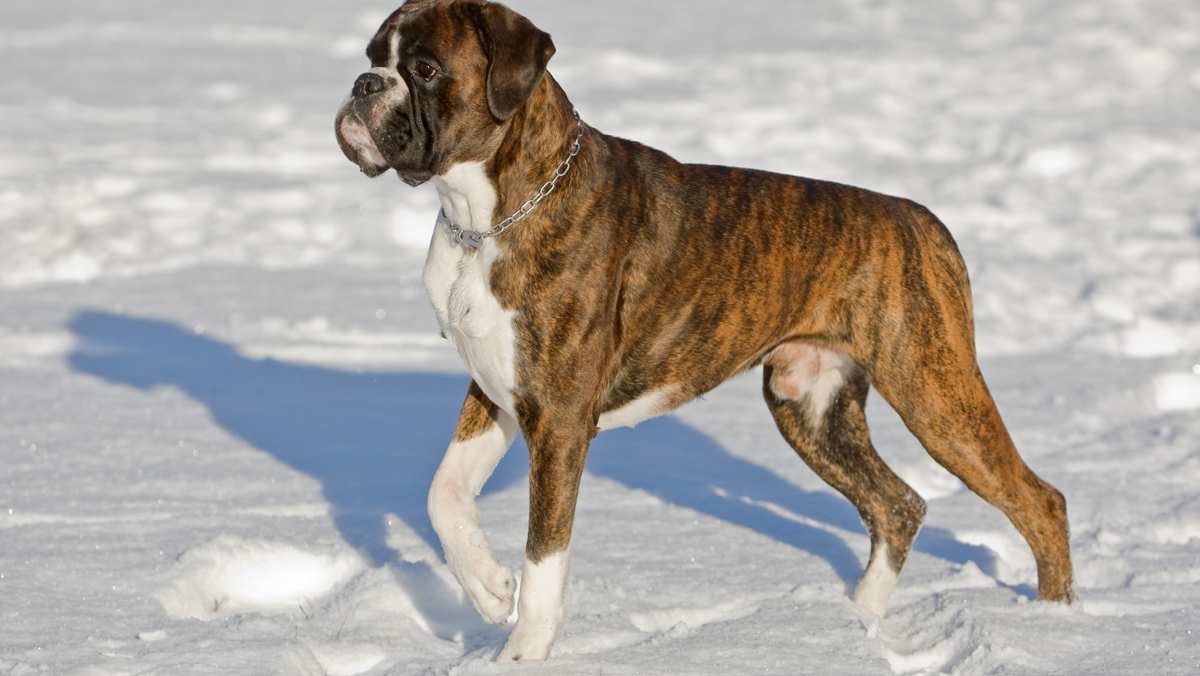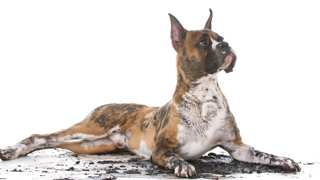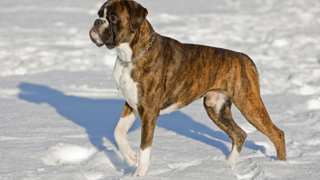American Boxer
American Boxer Dog
Boxer Dog
Boxer Puppy
Deutscher Boxer
German Boxer
Boxers are a large breed dog which were originally bred for guarding and protection services. This may come as no surprise since the breed's square face, muscular body, and sturdy build appears intimidating even to those familiar with the breed. The breed is a puppy at heart and its not uncommon for boxers to take 3 to 4 years before they are mentally mature.
Even though boxers were bred to be fearless guard dogs, they are loyal to their family and friendly to strangers and guests welcomed by their owners. They are very playful and full of energy. Boxers are an intelligent dog breed, however they are known for being headstrong so it may require patience to fully train the breed.
The Boxer is a former hunting dog whose companionship aspect has come to be the main reason most people get one of these dogs. They get along wonderfully with children but need to be trained to not be too playful, and they will bond closely with your family. They are not the best dog for first-time owners as they can be hard to train and may seek attention in annoying ways. They can adapt well enough to most any size home but they don't like to be left alone much, if at all.
Here are some Boxer facts that can help you decide if you wish to adopt a Boxer:
PROS
- Love kids
- Enjoy snuggling
- Great guard dogs
- Excellent watchdogs
- Good for active lifestyles
CONS
- Tend to bark a lot
- Separation anxiety
- Can be dog-aggressive
- Loves to leap on people
- May chase cats and other animals
Purebred
10 - 12 yrs.
21 - 25 in.
60 - 70 lbs
OverallFamily FriendlyChild FriendlyPet FriendlyStranger Friendly
Easy to GroomEnergy LevelExercise NeedsHealthShedding Amount
Barks / HowlsEasy to TrainGuard DogPlayfulnessWatch Dog
Apartment DogCan be AloneGood for Busy OwnersGood for New OwnersIntelligence
The boxer is a large dog breed with males getting as large as 25 inches (from ground to shoulder) and weighing as much as 70 pounds. They have high energy requirements for a large dog and require multiple walks daily or a 90 minutes of day of similar exercise. Due to their high exercise needs, boxers are not recommended for families that can't devote the time to keep their dog well exercised.
The boxer is an intelligent dog breed that is always in the mood to play. They are very alert dogs with a natural guarding instinct. The breed is good with children and other pets, but will be a bit wary of strangers approaching their family's property. Even though the boxer is a guard dog, they will welcome friendly strangers.
Boxers have a short coat, which doesn't provide very much protection from the cold. Because of this, the breed will need to remain indoors on days where you need to bundle up. The breed sheds, but brushing their coat weekly helps reduce excess hair from shedding.
The history of Boxers is a somewhat short one. This Molosser breed was developed by a small group of German breeders during the very late 19th century. The breeds that make a Boxer are said to have been a mastiff called the Bullenbeiser (aka the "bull biter," which is now extinct) and a variety of Bulldogs from England. The Boxer was produced to be a faster hunting dog meant to bring down the same large game as its ancestors: bears, wild boar, etc.
The origin of the breed name, Boxer, remains debated. Although there are distinct records starting around 1894 when the first Boxer club was formed, the name "Boxer" had been used as far back as 1845 in Charles Dickens's novella,"The Cricket on the Hearth." Many theories revolve around the dog's alleged habit to "box" while standing on his rear legs, but it may be more the fact that the dog prefers to head-butt when fighting. It could be that the breed's name was actually conceived in recognition of the German meaning for the term, prize fighter: boxer.
The first club, the Deutscher Boxer Club, was responsible for the first Boxer breed standard. The standard had been first drafted in 1902 and faced fierce competition from competing Boxer breeders. Nevertheless, the American Kennel Club (AKC) adopted the Deutscher's breed standard the same year it was published in 1904.
During WWI, Boxers were used for a great many tasks by the German military. Had they been left behind in Europe after the war, Boxer history may well have ended there too. After the war, Ally soldiers took rescued Boxers home to the United States, where the breed's popularity grew quickly. The dog's first AKC Championship was taken in 1915, and in 1935 the American Boxer Club was established.
Oddly enough, the Boxer is proportional in much the same way as a square box. Their block-shaped head and muscular body are all about sturdiness.
The Boxer's skull is somewhat "jowly" and will have a slight underbite. There is a distinctive set of wrinkles on their indented forehead. In some countries, cropping a dog's ears is illegal, and so you may see Boxers with their naturally floppy, natural ears that lay flat alongside the head. The big, dark eyes will accentuate these features. They have an elegant and strong neck that leads to a strong and straight back. The torso is lean torso but not thin. The front legs are of medium length and may look shorter than they are due to the deep chest. The feet are compact but may look large as they are high-arched. Their rear legs are very strong, and they will often have a docked tail. If the tail is not docked, it will be long.
The coat is short, smooth, tight and shiny. There should be no wrinkles save for the few on the forehead.
The images below represent the coat colors and patterns associated with Boxers.
There are big Boxers and there are small Boxers, and these are usually no smaller or larger than about 10% outside the AKC breed standard's size. There are, however, no micro, teacup, mini, toy, giant, XL, XXL or king Boxers. There are also no long haired Boxers, let alone any varieties. If you are told there are, you can be sure they have been crossed with some other dog breed.
There are Dwarf Boxers, but these are dogs that are born with a severe health condition that prevents the dog from fully maturing. It will also make them disproportionate, such as a properly sized head but a small body. On the other hand, you may have seen any one of the many biggest Boxer dog in the world photos. These are all fake.
The Boxer temperament is a fun-loving and playful one. Around most people, they will seek attention and big like a big puppy. Boxers are big dogs who try to be little lap dogs. They will want to be with you in a chair, on a couch, in a bed or wherever else they think they can fit even if they can't!
On the other hand, they can quickly become very protective and go into fierce guard mode if they feel threatened. One of the Boxer traits, loyalty, is one that is appreciable but must also be managed as they will not hesitate to be your bodyguard.
A Boxer's behavior is the most difficult when it comes to training, as these dogs are known to not be so much stubborn as simply not concerned. Patience, persistence and the right amount of treats is a good formula for shaping the typical Boxer character.
Boxers are very vocal dogs, especially as puppies, and it's a deep bark that can rattle you. In their non-stop quest for attention, these dogs are known for driving people batty with seemingly endless bouts of barking. If you are unsure how best to properly curb their barking, you may want to hire a professional dog trainer to help. They are protective of family members, but they should not be aggressive toward friends of the family. They are also prone to separation anxiety, and they will express this anxiety with chewing and — you guessed it! — barking.
Although Boxers need a lot of daily exercise, they don't need a huge yard. They will love a farm, of course, but if you live with a Boxer in an apartment, they will adapt.
Owning a Boxer as a pet is sure to raise the question, Are boxers hypoallergenic? They are not, and they are moderate shedders who drool a lot too.
Boxers tend to have a higher average number of health problems than most dog breeds.
Boxer puppies are rambunctious, and this can also be problematic. They need to develop their skeleton to be strong, and early rough-housing can be damaging. If you are going to adopt a Boxer puppy, you need to make sure you get the dog from a reputable breeder or rescue and get all the health tests.
Here are some of the health issues you should know about Boxers:
- Bloat
- Cancer
- Epilepsy
- Entropion
- Boxer colitis
- Hip dysplasia
- Skin problems
- Aortic stenosis
- Hypothyroidism
- Boxer eye ulcers
- Intestinal problems
- Boxer cardiomyopathy
- Intolerance to high heat
- Degenerative Myelopathy
- Sensitivity to acepromazine
The average lifespan for a Boxer is 10 to 12 years, a period which is somewhat short for this breed's size.
Below are potential health concerns associated with Boxers.
Bloat
Cancer
Corneal dystrophy
Hip dysplasia
Allergies
Hypothyroidism
Demodectic mange
Deafness
Aortic stenosis
Boxer cardiomyopathy





